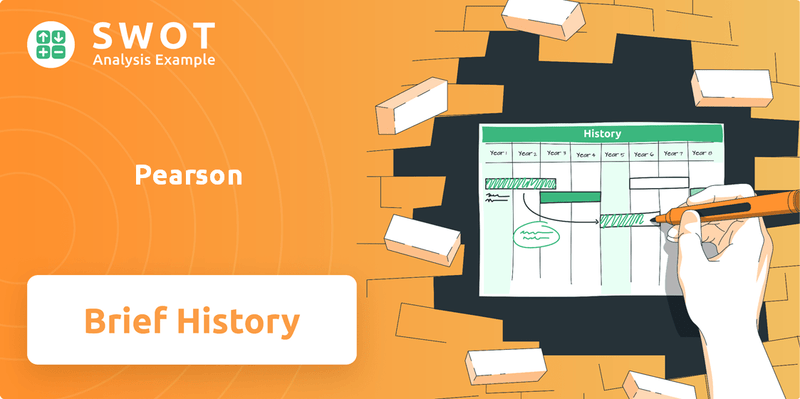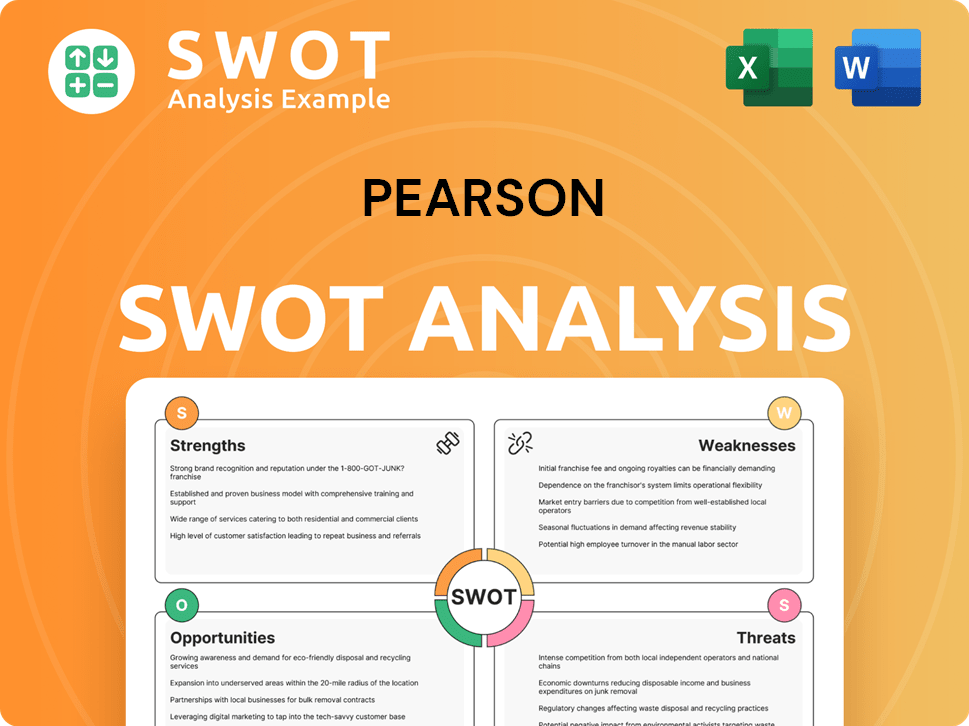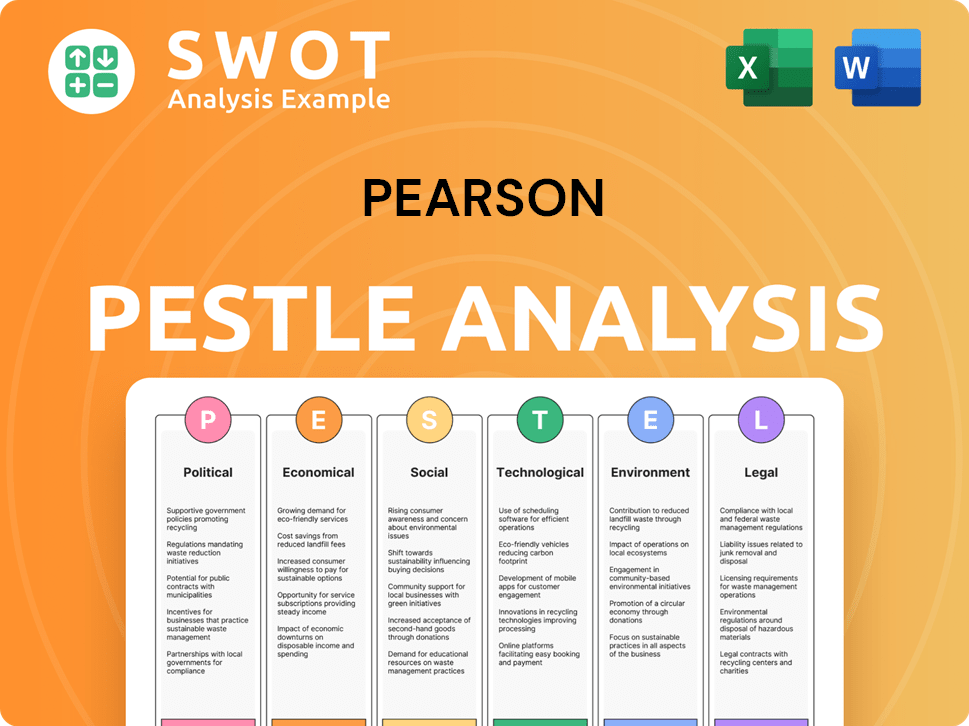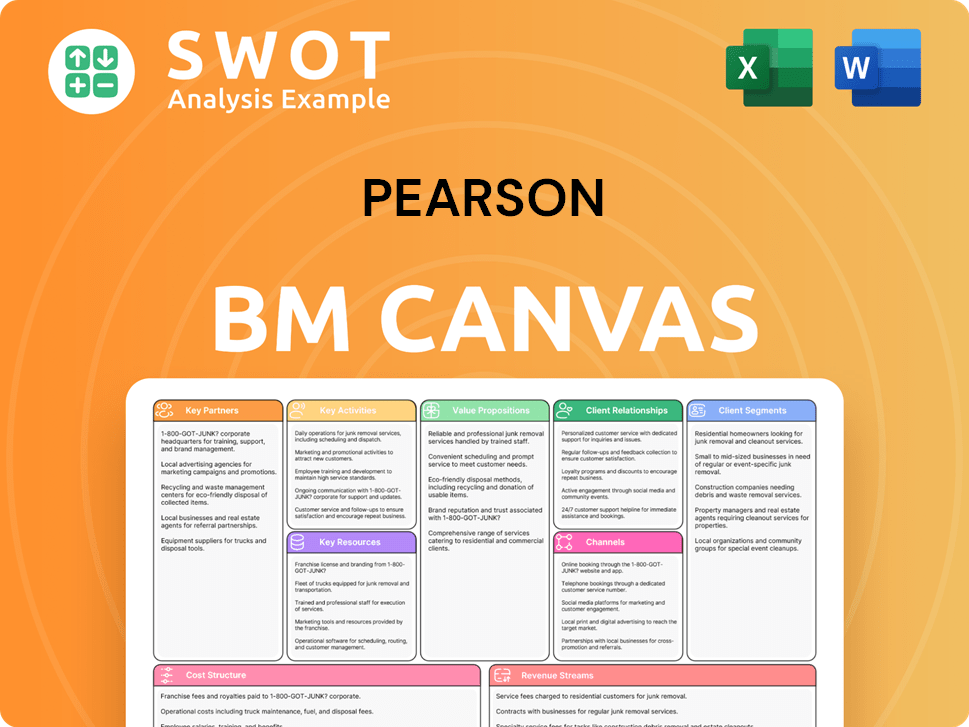Pearson Bundle
How did Pearson transform from a construction firm to a global education leader?
Journey back in time to discover the fascinating Pearson SWOT Analysis and the remarkable transformation of Pearson Company. From its roots in 1844 Yorkshire, England, Pearson's story is one of strategic pivots and relentless innovation. Explore how Pearson history unfolded, shaping its current status as a dominant force in global education.

This brief history of Pearson unveils its early business ventures and the pivotal Pearson acquisitions that fueled its growth. Understanding Pearson's evolution in publishing and its expansion into education provides valuable insights into its current business model and global presence. Delve into Pearson's financial performance history and its significant impact on education, including its role in standardized testing.
What is the Pearson Founding Story?
The story of the Pearson Company began in 1844, when Samuel Pearson established S. Pearson & Son in Yorkshire, England. This marked the genesis of what would become a global leader in education and publishing, a journey that started with a focus on construction and civil engineering.
Initially, the company's core business revolved around railway construction, capitalizing on the infrastructure boom of the Victorian era. This early focus set the stage for future diversification and expansion, laying the groundwork for the Pearson we know today.
Pearson's early success was significantly influenced by the Industrial Revolution, which fueled demand for robust infrastructure. This period was crucial for the company's early trajectory.
S. Pearson & Son quickly expanded beyond railway construction, undertaking diverse projects. This early diversification demonstrated the company's adaptability and ambition.
- Early projects included tunnels, docks, and the construction of the Blackwall Tunnel under the River Thames in London.
- Initial funding likely came from Samuel Pearson's personal capital and profits from early contracts.
- The company's business model was rooted in civil engineering and construction contracts.
- The cultural and economic context of the Industrial Revolution significantly influenced the company's creation and early trajectory.
Pearson SWOT Analysis
- Complete SWOT Breakdown
- Fully Customizable
- Editable in Excel & Word
- Professional Formatting
- Investor-Ready Format

What Drove the Early Growth of Pearson?
The Pearson Company's early years focused on construction, laying the foundation for its future. The company's expansion accelerated under Weetman Dickinson Pearson, Samuel Pearson's grandson, who took charge in 1894. This period marked the beginning of international projects and significant team growth for the company. The company's initial ventures were centered in Yorkshire, which later expanded to include offices in other locations.
Under Weetman Dickinson Pearson, the company secured major public works contracts globally. A key project was the construction of the Vera Cruz harbor in Mexico. This international focus helped establish the company's reputation and financial stability. The company's construction projects included railways, tunnels, and other infrastructure developments.
A strategic shift occurred in the early 20th century when the company diversified into publishing. This move began with the acquisition of a stake in the Westminster Press in 1920. This was a significant departure from its construction roots, marking the beginning of its transformation into a media and information powerhouse. This transition set the stage for future acquisitions and a new business model.
Over several decades, the company continued to acquire publishing and media companies. Notable acquisitions included the Financial Times in 1957 and a significant stake in Penguin Books in 1970. These acquisitions were crucial in reshaping the company's business model, shifting its focus away from construction. By the late 20th century, the company had largely divested its construction interests, completing its transformation into a media conglomerate.
The strategic shift from construction to publishing was a monumental decision that defined the company's future. This pivot allowed the company to become a major player in the publishing and media industries. The company's ability to adapt and evolve through acquisitions and strategic decisions has been key to its long-term success. The company's current business model is a direct result of these early strategic decisions.
The Pearson history is marked by several key acquisitions that reshaped its business. The acquisition of the Financial Times in 1957 and Penguin Books in 1970 were pivotal. These moves helped the company transition from construction to media and publishing. This evolution is a key aspect of understanding the company's growth. To understand the company's target market, you can read this article: Target Market of Pearson.
Pearson PESTLE Analysis
- Covers All 6 PESTLE Categories
- No Research Needed – Save Hours of Work
- Built by Experts, Trusted by Consultants
- Instant Download, Ready to Use
- 100% Editable, Fully Customizable

What are the key Milestones in Pearson history?
The Pearson Company has a rich history, marked by significant milestones that have shaped its evolution and impact on the education sector. This journey began with its founding and continued through strategic acquisitions and innovations, transforming it into a leading educational content and assessment provider. Its story is a testament to its adaptability and resilience in a constantly evolving market.
| Year | Milestone |
|---|---|
| 1844 | Founded as a construction business by Samuel Pearson in Yorkshire, England. |
| 1920s | Expanded into publishing with the acquisition of the Financial Times. |
| 1998 | Acquired Simon & Schuster's educational and professional publishing division, significantly boosting its presence in education. |
| 2000 | Acquired National Computer Systems (NCS), enhancing its assessment and testing capabilities. |
| 2015 | Divested the Financial Times to focus more on its education business. |
Pearson has consistently embraced innovation, especially in digital learning. The company has invested heavily in online platforms and resources to meet the changing needs of educators and learners. This focus has allowed it to adapt to the rapid advancements in educational technology, maintaining its position as a leader in the industry.
Pearson has been a pioneer in digital learning, developing online platforms and resources for education. This shift has allowed the company to reach a wider audience and offer more flexible learning options.
The acquisition of NCS enhanced Pearson's capabilities in assessment and testing. This has enabled the company to provide comprehensive evaluation tools that are essential for measuring student progress and educational outcomes.
Pearson continuously develops new educational content and resources to meet the evolving needs of educators and learners. This includes textbooks, digital materials, and online courses.
Pearson has established a strong global presence, providing educational products and services worldwide. This expansion has allowed the company to reach diverse markets and adapt to local needs.
Pearson has increased its direct-to-consumer offerings to provide more accessible and flexible learning options. This includes online courses and digital learning platforms.
Pearson is focusing on workforce skills development to meet the demands of the changing job market. This includes providing training and resources for professional development.
Despite its successes, Pearson has faced numerous challenges, including market downturns and competition from new ed-tech startups. The company has also had to adapt to shifts in the educational landscape, including the rise of open educational resources and changing consumer preferences.
Economic downturns have impacted Pearson's traditional publishing revenues. The global financial crisis affected the company's financial performance, requiring strategic adjustments.
Competition from ed-tech startups and open educational resources has presented significant challenges to Pearson. The company has had to innovate and adapt to stay competitive in the market.
Pearson has experienced product failures, requiring the company to learn from its mistakes and refine its strategies. These failures have led to a need for better market research and product development.
The company has undergone internal restructuring efforts to adapt to changing market demands. These efforts have included divesting non-core assets and streamlining operations.
The shift to digital offerings has required significant investment and strategic pivots. Pearson has had to adapt its business model to focus on digital products and online learning platforms.
Pearson has made strategic pivots, including a stronger emphasis on direct-to-consumer offerings and workforce skills development. These pivots have helped the company stay relevant and competitive.
Pearson Business Model Canvas
- Complete 9-Block Business Model Canvas
- Effortlessly Communicate Your Business Strategy
- Investor-Ready BMC Format
- 100% Editable and Customizable
- Clear and Structured Layout

What is the Timeline of Key Events for Pearson?
The brief history of Pearson is marked by significant shifts and strategic decisions. From its origins in construction to its evolution into a global leader in education, Pearson's journey reflects its adaptability and commitment to meeting societal needs. Key moments include major acquisitions and strategic divestitures that have shaped its current focus on digital learning and workforce skills development.
| Year | Key Event |
|---|---|
| 1844 | Samuel Pearson founded S. Pearson & Son, a construction firm, marking the initial steps of the |
| 1894 | Weetman Dickinson Pearson took over the family business, expanding it internationally. |
| 1920 | Pearson diversified into publishing with an investment in the Westminster Press, indicating its early interest in media. |
| 1957 | Pearson acquired the Financial Times, a significant move into financial publishing. |
| 1970 | Pearson acquired a significant stake in Penguin Books, strengthening its position in book publishing. |
| 1998 | Pearson acquired Simon & Schuster's educational and professional publishing division, expanding its educational offerings. |
| 2000 | Pearson acquired National Computer Systems (NCS), enhancing its assessment capabilities. |
| 2015 | Pearson divested the Financial Times to focus solely on education, a pivotal strategic shift. |
| 2020 | Pearson saw increased demand for online learning due to the global pandemic, accelerating its digital transformation. |
| 2023 | Pearson reported a 10% adjusted operating profit margin and 86% digital product sales, demonstrating its focus on digital growth. |
Pearson is strategically expanding its digital learning offerings, focusing on virtual learning and workforce skills development. This expansion aims to capitalize on the growing demand for flexible and accessible education solutions worldwide. The company's investments in AI-powered learning tools and adaptive assessments are expected to drive further growth in the digital education market. The company is well-positioned to leverage its extensive content library and technological capabilities.
The company is committed to lifelong learning and addressing the skills gap in the global workforce. This focus aligns with the evolving needs of the job market and the increasing demand for skilled workers. Pearson's initiatives in workforce skills development are designed to provide individuals with the necessary tools and knowledge to succeed in their careers. This commitment is a key element of Pearson's long-term strategy.
Pearson continues to invest in AI-powered learning tools and adaptive assessments to enhance the learning experience. These technologies provide personalized learning paths and real-time feedback to students. The use of AI also allows for more efficient and effective assessment of student progress. This investment in technology is a key part of Pearson's strategy.
Analysts predict continued growth in the digital education market, with
Pearson Porter's Five Forces Analysis
- Covers All 5 Competitive Forces in Detail
- Structured for Consultants, Students, and Founders
- 100% Editable in Microsoft Word & Excel
- Instant Digital Download – Use Immediately
- Compatible with Mac & PC – Fully Unlocked

Related Blogs
- What is Competitive Landscape of Pearson Company?
- What is Growth Strategy and Future Prospects of Pearson Company?
- How Does Pearson Company Work?
- What is Sales and Marketing Strategy of Pearson Company?
- What is Brief History of Pearson Company?
- Who Owns Pearson Company?
- What is Customer Demographics and Target Market of Pearson Company?
Disclaimer
All information, articles, and product details provided on this website are for general informational and educational purposes only. We do not claim any ownership over, nor do we intend to infringe upon, any trademarks, copyrights, logos, brand names, or other intellectual property mentioned or depicted on this site. Such intellectual property remains the property of its respective owners, and any references here are made solely for identification or informational purposes, without implying any affiliation, endorsement, or partnership.
We make no representations or warranties, express or implied, regarding the accuracy, completeness, or suitability of any content or products presented. Nothing on this website should be construed as legal, tax, investment, financial, medical, or other professional advice. In addition, no part of this site—including articles or product references—constitutes a solicitation, recommendation, endorsement, advertisement, or offer to buy or sell any securities, franchises, or other financial instruments, particularly in jurisdictions where such activity would be unlawful.
All content is of a general nature and may not address the specific circumstances of any individual or entity. It is not a substitute for professional advice or services. Any actions you take based on the information provided here are strictly at your own risk. You accept full responsibility for any decisions or outcomes arising from your use of this website and agree to release us from any liability in connection with your use of, or reliance upon, the content or products found herein.